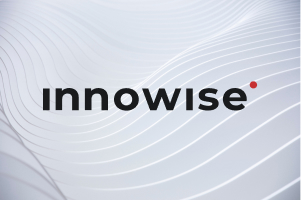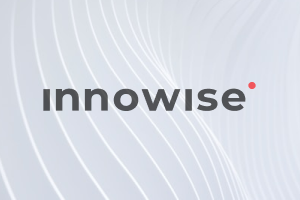A sua mensagem foi enviada.
Processaremos o seu pedido e contactá-lo-emos logo que possível.
O formulário foi enviado com sucesso.
Encontrará mais informações na sua caixa de correio.

Selecionar a língua

A terceirização do desenvolvimento de SaaS pode parecer uma decisão de alto risco. Por um lado, dá-lhe acesso a talentos de primeira linha e um tempo de colocação no mercado mais rápido. Por outro lado, existem alguns riscos: escolher o fornecedor errado, lidar com vulnerabilidades de segurança ou acabar com um produto que não se dimensiona à medida que sua empresa cresce.
A contratação de uma equipa interna pode parecer uma aposta mais segura. No entanto, é dispendioso e moroso. Necessitará de especialistas em infra-estruturas de nuvem, DevOps, segurança e UI/UX.
A subcontratação, quando bem feita, oferece flexibilidade e a experiência necessária para criar um produto SaaS seguro e escalável. A chave é escolher o parceiro certo.
É aí que Innowise entra, um líder em terceirização de desenvolvimento de SaaS. Nós ajudamos empresas em todo o mundo a criar soluções SaaS de alto desempenho e prontas para o futuro.
Este guia explica tudo o que precisa de saber - desde encontrar um fornecedor fiável até estabelecer uma colaboração harmoniosa - para que possa subcontratar com confiança o desenvolvimento SaaS sem erros dispendiosos. Vamos mergulhar.
Criar um produto SaaS de raiz não é tarefa fácil. É um investimento enorme em tempo, dinheiro e esforço - e os riscos são elevados.
Como disse acima, criar uma solução fiável, escalável e segura não é fácil... nem barato. É por isso que a subcontratação pode ser um caminho mais inteligente para obter a experiência de que necessita sem as despesas gerais de uma equipa interna. Vamos explicar porque é que faz sentido.
Vamos falar de dinheiro - porque, sejamos honestos, essa é normalmente a primeira preocupação. A contratação de uma equipa de desenvolvimento interna a tempo inteiro não se resume ao pagamento de salários. É preciso ter em conta os custos de recrutamento, benefícios, espaço de escritório (mesmo que seja remoto, precisa de infra-estruturas), formação e o mais importante - a rotatividade. Os bons programadores não são baratos e a perda de um a meio do projeto pode atrasá-lo durante meses.
A subcontratação permite-lhe aceder a um conjunto global de talentos onde os custos são significativamente mais baixos. Por exemplo, na América do Norte e na Europa Ocidental, contratar um programador pode custar entre $50 e $300 por hora. Em contrapartida, programadores com as mesmas competências em regiões como a Europa de Leste ou a América Latina normalmente carregam entre $25 e $199.
Para colocar isto em perspetiva, eis como se comparam os custos de desenvolvimento interno e externo:
| Despesas | Equipa interna (EUA/Europa Ocidental) | Equipa subcontratada (Europa de Leste, América Latina, Ásia) |
| Contratação e recrutamento | $15.000+ por programador | $0 (tratado por uma empresa de externalização) |
| Salários (desenvolvimento sénior) | $120,000-$180,000 por ano | $40,000-$80,000 por ano |
| Benefícios e despesas gerais | 30-50% do salário | Mínimo ou incluído no contrato |
| Escritório e equipamento | $5,000+ por empregado anualmente | $0 (equipas remotas) |
| Formação e integração | $5,000-$10,000 por dispositivo | $0 (peritos pré-selecionados) |
| Custo anual total | $200.000+ por programador | $50,000-$100,000 por programador |
Principal conclusão? O desenvolvimento interno pode ser 2-4x mais caro do que a subcontratação, dependendo da localização e da complexidade do projeto.
A subcontratação elimina estas despesas gerais, permitindo que as empresas concentrem os seus recursos no crescimento, no marketing e na aquisição de clientes, em vez de se concentrarem nas despesas com os salários.
E não se trata apenas de salários - a externalização pode reduzir os custos totais de desenvolvimento até 40% em comparação com as equipas internas.
Além disso, com a subcontratação, só paga o que precisa. Sem custos gerais, sem programadores inactivos à espera de tarefas, apenas produtividade pura.
Contratar uma equipa full-stack com conhecimentos de SaaS não é apenas dispendioso - é incrivelmente difícil. A forte equipa de desenvolvimento SaaS requer especialistas em arquitetura de nuvem, DevOps, design UI/UX, segurança e desenvolvimento backend. Encontrar todas estas competências internamente é um verdadeiro pesadelo de recrutamento.
Ao subcontratar, obtém acesso imediato a especialistas pré-selecionados, especializados em soluções SaaS.
Estes programadores já criaram e lançaram plataformas SaaS, o que significa que trazem para a mesa estruturas comprovadas, melhores práticas e conhecimentos do sector. Em vez de reinventar a roda, eles aplicam metodologias testadas e comprovadas que colocam seu produto no mercado mais rapidamente.
Quer necessite de alguns especialistas de nicho ou de toda uma equipa de desenvolvimento dedicada, pode escalar a sua equipa sem esforço.
A velocidade é tudo no SaaS. Quanto mais tempo o seu produto estiver em desenvolvimento, mais dinheiro gasta - e maior é a probabilidade de um concorrente o vencer no mercado.
A externalização acelera o desenvolvimento de três formas principais:
As empresas que adoptam estratégias de subcontratação ágeis e enxutas podem reduzir o tempo de colocação no mercado até 30%. Trata-se de um fator de mudança, especialmente em indústrias em rápida evolução.
Se está a criar uma empresa SaaS, a sua prioridade deve ser o crescimento, a aquisição de clientes e a estratégia de produto - não depurando código ou lidando com configurações de servidor.
Pense nisso: O seu CEO precisa de se preocupar com a conformidade da segurança na nuvem? Sua equipe de administração de TI deve estar envolvida em otimizações de banco de dados? Não. A terceirização permite que você delegue complexidades técnicas para que sua equipe interna possa se concentrar no crescimento dos negócios, nas vendas e na experiência do cliente.
A subcontratação não significa perder o controlo - significa entregar a execução a especialistas enquanto orienta a empresa na direção certa.
A subcontratação dá-lhe a flexibilidade de aumentar ou diminuir a sua equipa de desenvolvimento com base na procura. Precisa de mais programadores antes do lançamento? Fácil. Precisa de reduzir durante as fases de manutenção? Não há problema.
A capacidade de se adaptar a cargas de trabalho flutuantes é crucial, especialmente se estiver a construir um produto SaaS que espera um rápido crescimento do utilizador. A última coisa que quer é uma equipa interna que seja demasiado pequena para grandes projectos e demasiado grande para períodos lentos.
O lançamento de um produto SaaS é um desafio cheio de pressão, e cada passo tem potenciais armadilhas:
Um bom parceiro de subcontratação atenua estes riscos ao trazer para o projeto uma experiência testada em combate, conhecimentos de conformidade de segurança e fluxos de trabalho ágeis. Eles já lidaram com desafios semelhantes antes e sabem como abordar proactivamente potenciais problemas antes que se tornem erros dispendiosos.
Por exemplo, as falhas de segurança SaaS resultam normalmente de configurações incorrectas e de más práticas de codificação - ambas as quais podem ser evitadas trabalhando com programadores experientes que seguem as melhores práticas de segurança desde o primeiro dia.
Externalizar o seu desenvolvimento SaaS não é tão simples como escolher um fornecedor e esperar pelo melhor. Para obter os melhores resultados, é necessária uma abordagem estruturada - uma abordagem que garanta que o seu projeto se mantém alinhado com os seus objectivos, funciona sem problemas e, em última análise, fornece um produto de alta qualidade.
Vamos analisar o processo passo a passo.
Antes mesmo de pensar em contratar um parceiro de outsourcing, é necessário ter tudo em ordem. O que está a construir exatamente? Para quem é? Como é que vai evoluir ao longo do tempo?
Comece por responder a estas perguntas-chave:

Depois de ter uma visão clara do que precisa, é altura de documentar tudo num RFP (Pedido de Proposta). Pense nisto como o currículo do seu projeto - diz aos potenciais fornecedores exatamente o que procura, garantindo que atrai o talento certo.
O seu RFP deve incluir:
Agora vem o trabalho de detetive. Com o seu RFP na mão, está na altura de pesquisar e encontrar os melhores parceiros de outsourcing. Mas por onde é que se começa?
Onde encontrar fornecedores fiáveis de externalização de SaaS
Pode começar a sua pesquisa por plataformas de avaliação externa como Clutch e Boas empresasonde encontrará avaliações e classificações de clientes verificadas. Além disso, considere:
Dito isto, nem todos os fornecedores de serviços externos oferecem o mesmo nível de serviço. Dependendo das suas necessidades e do seu orçamento, pode considerar freelancers, agências locais ou empresas de desenvolvimento offshore. Eis como se comparam:
| Critérios | Freelancers | Agências locais | Empresas de desenvolvimento offshore |
| Custo | 💲 Mais baixo, mas varia muito | 💲💲 💲Mais elevado devido aos salários regionais | Preços competitivos, inferiores aos das agências locais |
| Especialização | Misto - depende do indivíduo | Forte especialização em nichos específicos | Vasta experiência em todos os sectores e pilhas de tecnologia |
| Escalabilidade | Limitado - uma pessoa ou uma pequena equipa | Moderado - pode expandir-se, mas é dispendioso | Elevada - pode aumentar ou diminuir rapidamente conforme necessário |
| Fiabilidade | Risco - pode abandonar o projeto ou atrasar os trabalhos | Fiável mas caro | Fiável com uma gestão de projectos estruturada |
| Segurança e conformidade | Baixo - pode não ter medidas de segurança adequadas | Moderado - aplicam-se normas de conformidade regionais | Elevada - as equipas experientes seguem protocolos de segurança rigorosos |
| Melhor para | Projectos pequenos e não críticos | Projectos SaaS de média dimensão com um âmbito definido | Desenvolvimento SaaS escalável e a longo prazo com necessidades de segurança e conformidade |
Factores a ter em conta num parceiro de externalização de SaaS
Depois de ter compilado uma lista de potenciais fornecedores, filtre-os com base em:
Sinais de alerta a evitar ao escolher um fornecedor
Esteja também atento a estes sinais de alerta. Por exemplo, contratos pouco claros. Se um fornecedor se recusar a fornecer um contrato estruturado com marcos bem definidos, SLAs e propriedade de IP, pode não ser digno de confiança.
Falta de transparênciatambém é um sinal de alerta. Os fornecedores que evitam compartilhar estudos de caso, referências de clientes ou estruturas de preços claras podem estar escondendo algo ou exagerando sua experiência.
O mesmo é válido para baixos padrões de segurança. Se um fornecedor não seguir a conformidade com o GDPR, HIPAA ou PCI DSS, a sua plataforma SaaS pode correr sérios riscos de violações de dados ou problemas legais.
Se um fornecedor afirma que pode criar um produto SaaS complexo em tempo recorde, é provável que esteja a cortar na qualidade. Prometer prazos excessivos é um grande não.
E finalmente, má comunicação. Respostas lentas, respostas vagas ou a ausência de um gestor de projeto dedicado podem levar a desalinhamentos e atrasos.
Como efetuar as entrevistas iniciais
Depois de ter reduzido a sua lista, é altura de falar. Marque chamadas de descoberta com potenciais fornecedores e faça perguntas como:
Dê vida à sua visão SaaS com programadores especializados
Agora que já selecionou alguns fornecedores promissores, está na altura de verificar a realidade. O facto de parecerem óptimos no papel não significa que vão cumprir o prometido. É necessária uma forma estruturada de avaliar as suas capacidades, fiabilidade e adequação ao seu projeto SaaS. É aí que entram os KPIs.
Para uma análise aprofundada de como a inteligência comercial e a experiência em segurança podem fortalecer sua oferta de SaaS, considere consultar a Innowise.
Antes de se comprometer com um contrato a longo prazo, tem de ver o seu fornecedor em ação. Um portfólio e testemunhos brilhantes são óptimos, mas não lhe dizem como a equipa de facto funciona em condições reais de projeto. É por isso que os workshops de fornecedores ou os projectos-piloto são úteis - permitem-lhe testar a colaboração antes de fazer um investimento total.
Workshops: sentir a colaboração
Um workshop de fornecedor é uma sessão curta e estruturada em que descreve o seu projeto SaaS em pormenor e vê como o fornecedor analisa os requisitos, sugere soluções e desafia os pressupostos. Essa é uma ótima maneira de avaliar a capacidade deles:
Mesmo um workshop de um dia pode revelar se a equipa é estratégica e inovadora ou se é apenas mais uma fábrica de código.

Projectos-piloto: testar a execução real
Se o workshop correr bem, o passo seguinte é um projeto-piloto em pequena escala - um teste do trabalho de desenvolvimento real. Em vez de entregar toda a sua plataforma SaaS desde o primeiro dia, atribua-lhes um único módulo, funcionalidade ou prova de conceito técnico. Isto ajuda-o a avaliar:
Dica profissional: Escolha um projeto-piloto que não seja de missão crítica, mas que seja relevante para o seu roteiro SaaS. Dessa forma, mesmo que as coisas não funcionem, não terá perdido tempo com uma funcionalidade inútil.
O próximo passo? Finalizar o contrato e garantir que tudo está legalmente correto.
Nesta altura, já avaliou o fornecedor, testou as suas competências e decidiu avançar. Mas antes que qualquer código seja escrito, você precisa de um contrato sólido - um que proteja os seus interesses, defina expectativas claras e evite mal-entendidos dispendiosos no futuro.
Um contrato de subcontratação bem estruturado não é apenas um jargão jurídico - é um roteiro para uma colaboração bem sucedida e sem conflitos. Eis o que deve ser incluído:
Dica profissional: Se um fornecedor resistir à transferência de propriedade intelectual ou ao pagamento de etapas, reconsidere - estes são sinais de alerta. Saiba mais sobre acordos de subcontratação estruturada em Como funciona o Innowise.
Mesmo a melhor parceria de outsourcing pode falhar sem uma comunicação clara e consistente. É necessário um sistema estruturado para garantir que todos se mantêm alinhados, que o progresso é transparente e que os problemas são resolvidos atempadamente. Eis como o fazer corretamente:
Dica profissional: Se um fornecedor não tiver um plano de comunicação claro, pode haver atrasos, interpretações erradas e perda de tempo. Defina as expectativas desde o início.
Uma vez assinado o contrato, é altura de preparar o seu fornecedor para o sucesso. Um processo de integração sólido garante que têm tudo o que é necessário para começar a trabalhar - sem atrasos desnecessários.
Primeiro, conceder acesso a recursos-chave. Partilhe a documentação, as credenciais e os sistemas relevantes para que a equipa possa começar a trabalhar imediatamente.
Segundo, esclareça sua marca e seu público. Forneça informações sobre seus usuários-alvo, metas comerciais e cenário competitivo para alinhar as expectativas.
Por fim, definir fluxos de trabalho e funções. Estabeleça quem é responsável pelo quê, como as actualizações serão partilhadas e as melhores formas de tratar as aprovações e o feedback.
Quando o desenvolvimento está em curso, é necessário ter visibilidade do progresso e da qualidade para manter tudo no caminho certo. As métricas corretas garantem que o seu produto SaaS está a ser construído a tempo, dentro do orçamento e de acordo com as normas.

Nenhum projeto está completamente isento de riscos, mas a antecipação de potenciais armadilhas pode salvá-lo de grandes dores de cabeça ao longo do caminho. A chave é a deteção precoce e o planeamento de contingências para manter o seu desenvolvimento SaaS no caminho certo.
Cuidado com o alargamento do âmbito. Alterar os requisitos a meio do desenvolvimento pode fazer descarrilar os prazos e os orçamentos. Defina claramente o âmbito do contrato e utilize protocolos de pedidos de alteração.
Tentar evitar atrasos e falhas de comunicação. Os controlos regulares e os relatórios estruturados ajudam a detetar precocemente os estrangulamentos antes que se transformem em problemas graves.
E, incluir planos de emergência. Prever tempo de reserva para atrasos inesperados e ter uma estratégia de reserva para membros críticos da equipa ou recursos adicionais, se necessário.
Este é o momento da verdade - o seu produto SaaS está quase pronto, mas um lançamento apressado sem as devidas verificações pode levar a problemas de desempenho, vulnerabilidades de segurança e utilizadores frustrados. Testes rigorosos, uma infraestrutura sólida e uma estratégia de implementação inteligente garantem um lançamento sem problemas.
Primeiro,executar testes extensivos. Realize testes funcionais, de desempenho, de segurança e de aceitação do usuário (UAT) para detetar e corrigir problemas antes do lançamento.
Em segundo lugar, prepare a infraestrutura de implantação. Trabalhe com seu fornecedor para configurar a hospedagem na nuvem, o dimensionamento automático e as ferramentas de monitoramento para garantir o tempo de atividade e a confiabilidade. A escolha da plataforma de nuvem correta é crucial. Ela pode ser AWS, Azure, Kubernetes ou sua solução de nuvem interna, ou armazenamento local.
Mesmo com uma infraestrutura sólida, a monitorização em tempo real é essencial após o lançamento. Ferramentas como New Relic (monitorização do desempenho), Datadog (monitorização da nuvem) e Sentry (deteção de erros) ajudam a detetar e a resolver problemas antes que estes afectem os utilizadores.
Utilize uma estratégia de implementação inteligente. Em vez de lançamentos arriscados de uma só vez, opte por:
Por último, dê formação à sua equipa e documente os processos para garantir uma transferência de conhecimentos sem problemas. Uma documentação bem estruturada ajuda o seu pessoal interno a compreender como utilizar, gerir e apoiar o produto eficazmente. Isto facilita a integração de novos membros da equipa e garante uma gestão consistente dos produtos em toda a empresa.
O lançamento do seu produto SaaS não é o ponto de chegada - é apenas o começo. Manutenção e melhorias contínuas são essenciais para manter a sua plataforma segura, eficiente e competitiva. Sem um plano de suporte pós-lançamento sólido, os bugs, as vulnerabilidades de segurança e as funcionalidades desactualizadas podem rapidamente corroer a confiança dos utilizadores.
Para garantir o sucesso a longo prazo, certifique-se de que o seu fornecedor fornece:
O seu produto SaaS está no ar - mas como sabe se é verdadeiramente bem sucedido? A otimização pós-lançamento é tão importante como o desenvolvimento. O acompanhamento regular das principais métricas ajuda-o a afinar o desempenho, a melhorar a experiência do utilizador e a maximizar as receitas.
Em primeiro lugar, monitorizar envolvimento e retenção dos utilizadores. Os dados sobre inscrições, taxa de rotatividade e utilização de funcionalidades ajudá-lo-ão a compreender como os clientes interagem com a sua plataforma.
É claro que também é necessário calcular o ROI e o crescimento das receitas. Acompanhe as taxas de subscrição, o valor do tempo de vida do cliente (CLV) e os custos de aquisição para garantir a rentabilidade.
Finalmente, avaliar a escalabilidade e o desempenho. Teste a forma como o seu sistema lida com o aumento do tráfego, garantindo que se mantém rápido e estável à medida que a procura aumenta.
Dica profissional: Utilize testes A/B, ferramentas de análise e ciclos de feedback dos clientes para efetuar melhorias baseadas em dados e manter o seu SaaS competitivo.
Com tudo pronto, subcontratou e lançou com sucesso o seu produto SaaS - mas a viagem não acaba aqui. A iteração e o crescimento contínuos são o que faz com que uma empresa SaaS prospere.
Mesmo com uma estratégia de subcontratação sólida, o sucesso não se resume à escolha do fornecedor correto - trata-se de tomar decisões informadas em todas as fases. Aqui estão algumas das melhores práticas para garantir que o seu desenvolvimento SaaS decorre sem problemas e proporciona um verdadeiro valor comercial.
Um produto SaaS sólido não se resume a excelentes funcionalidades - trata-se de resolver o problema certo para os utilizadores certos. Antes de subcontratar o desenvolvimento, certifique-se de que tem uma visão bem definida, baseada nas necessidades reais dos utilizadores.
Comece por identificar quem é o seu público-alvo e quais os desafios específicos que enfrentam.
Não parta do princípio de que sabe o que os utilizadores querem. validar tudo com dados. As melhores empresas de SaaS fazem iterações com base no comportamento do utilizador e não apenas na intuição.
Realize entrevistas com clientes, pesquisas com concorrentes e análises comportamentais para descobrir pontos problemáticos e validar a procura. Compreender os seus utilizadores ajuda-o a aperfeiçoar o seu conjunto de funcionalidades, as expectativas de usabilidade e a estratégia de preços - assegurando que os esforços de desenvolvimento estão alinhados com as necessidades reais do mercado e não com suposições.
Assim que tiver um perfil de público claro, defina as suas principais funcionalidades, objectivos de escalabilidade e requisitos de conformidade (por exemplo, GDPR, HIPAA). Também é importante distinguir entre as funcionalidades obrigatórias e as que são agradáveis - isto dá ao seu parceiro de outsourcing de SaaS a flexibilidade para otimizar o desenvolvimento, ao mesmo tempo que garante que os seus objectivos comerciais essenciais são cumpridos.
Dica profissional: Definir um "não negociável vs. flexível" lista para as suas necessidades. Indique claramente quais as caraterísticas, os padrões de desempenho e as necessidades de conformidade que são absolutamente indispensáveis e quais são opcionais ou iterativas.
Isto ajuda os fornecedores a dar prioridade ao desenvolvimento e a evitar atrasos desnecessários, assegurando simultaneamente que os seus objectivos principais são cumpridos. Desta forma, evita o desfasamento do âmbito, simplifica a tomada de decisões e garante que, mesmo que sejam necessários ajustes, a visão principal do produto permanece intacta.
O desenvolvimento de SaaS não é um processo único - requer feedback contínuo, melhorias incrementais e adaptabilidade à evolução das necessidades dos utilizadores.
É por isso que o desenvolvimento ágil é a abordagem preferida para a terceirização de SaaS. Em vez de esperar meses por um produto totalmente construído, o Agile garante que os recursos sejam lançados em iterações, permitindo um tempo de colocação no mercado mais rápido e refinamentos contínuos com base no feedback real do usuário.
Para que o Agile funcione eficazmente com o seu parceiro de externalização, certifique-se de que este
Dica profissional: Um fornecedor resistente a métodos ágeis pode não ser o mais adequado para um produto SaaS em rápida evolução.
Ao subcontratar o desenvolvimento SaaS, a propriedade do código, dos dados e dos projectos não deve ser negociável. Antes de assinar um contrato, esclareça estes pontos-chave:
Dica profissional: Alguns fornecedores retêm direitos parciais de reutilização de código - certifique-se de que o seu contrato impede esta situação. Defina claramente as cláusulas de exclusividade para proteger o seu produto SaaS de ser reutilizado pelos concorrentes.

Uma relação de subcontratação bem sucedida vai para além da simples entrega de um produto - trata-se de construir uma colaboração fiável e a longo prazo. Para o conseguir:
Dica profissional: Envolva o seu fornecedor nas principais discussões comerciais, sessões de feedback dos clientes e roteiros de produtos. Quanto mais ele compreender a sua visão, mais eficaz será no fornecimento de uma solução escalável e preparada para o futuro.
“Já vi demasiadas empresas apressarem-se a recorrer à subcontratação apenas para pouparem custos, acabando por ficar com um produto que não corresponde às suas expectativas. A chave é encontrar um parceiro que compreenda verdadeiramente os seus objectivos - não apenas um que codifique o que está na folha de especificações. Quando trata a sua equipa de outsourcing como parte da sua própria equipa, é aí que a verdadeira inovação acontece.“

Dmitry Nazarevich
CTO no Innowise
O lançamento do seu produto SaaS é apenas o começo - o sucesso vem das melhorias contínuas. Mantenha-se à frente:
Dica profissional: O sucesso do SaaS não tem a ver com o lançamento rápido - tem a ver com a iteração baseada em dados reais. Os melhores produtos evoluem continuamente para satisfazer as exigências dos utilizadores e as tendências do mercado.
Ao subcontratar SaaS, precisa de um parceiro com conhecimentos profundos, um historial comprovado e um compromisso de fornecer soluções escaláveis e de elevado desempenho.
Innowise traz 18 anos de experiência em desenvolvimento de software e oferece serviços de outsourcing de desenvolvimento SaaS de ponta a ponta, desde a validação da ideia até ao lançamento e apoio pós-lançamento.
Com uma equipa personalizada de programadores, designers, analistas e gestores de projectos, garantimos que cada projeto está alinhado com os objectivos comerciais e os requisitos técnicos.
Tendo entregado com sucesso 500+ projetos, a Innowise é especializada na construção de arquiteturas multi-inquilino, soluções nativas da nuvem e plataformas SaaS seguras e alimentadas por IA.
A nossa experiência estende-se a vários sectores, incluindo fintech, cuidados de saúde e automação empresarial. Explore a nossa Estudos de caso SaaS para ver como ajudámos as empresas a criar e escalar produtos SaaS inovadores.
Quer esteja a começar do zero ou a otimizar uma plataforma existente, Serviços de outsourcing da Innowise fornecem a flexibilidade, a fiabilidade e a experiência necessárias para transformar a sua visão em realidade.












A sua mensagem foi enviada.
Processaremos o seu pedido e contactá-lo-emos logo que possível.

Ao inscrever-se, o utilizador concorda com a nossa Política de privacidadeincluindo a utilização de cookies e a transferência das suas informações pessoais.